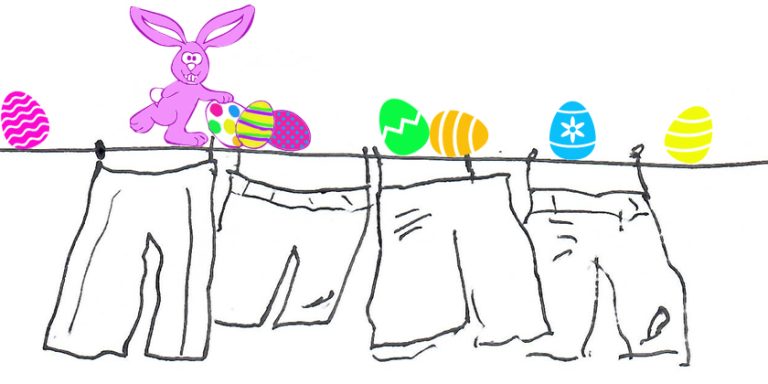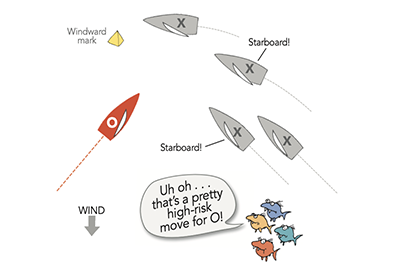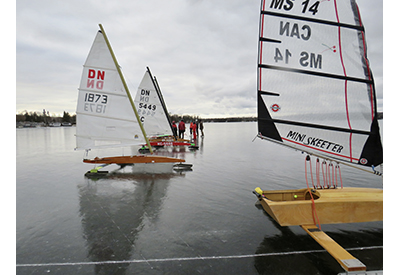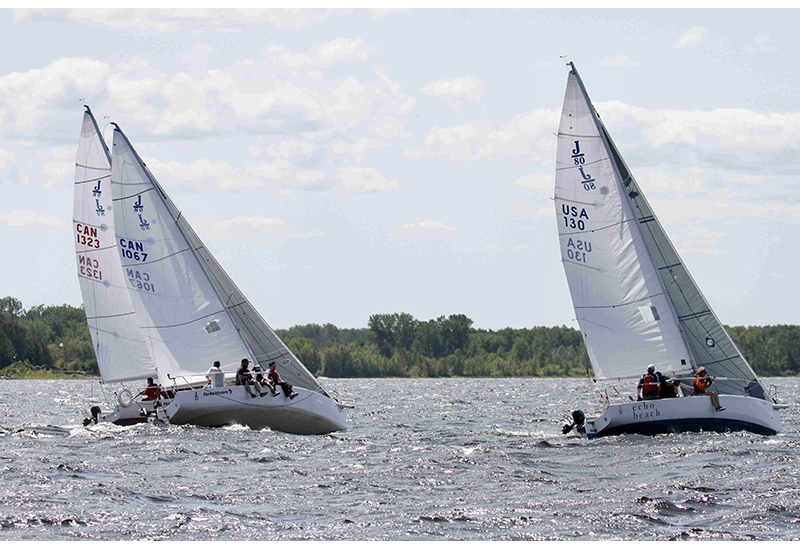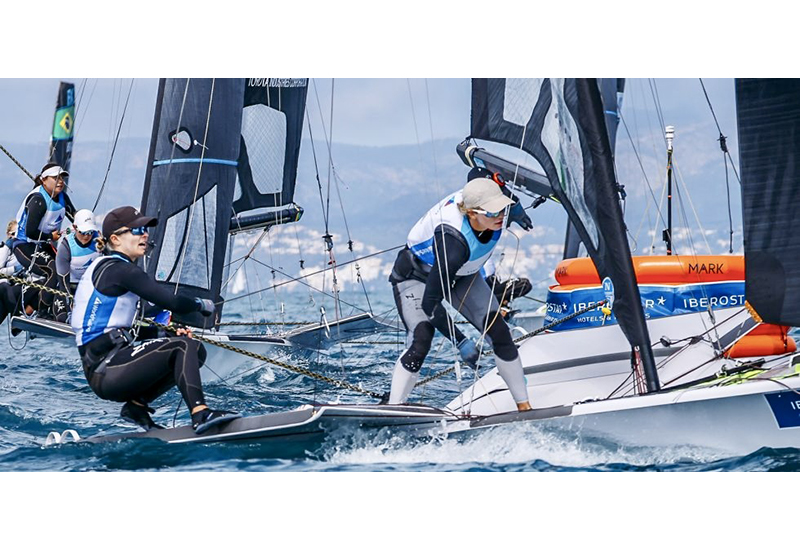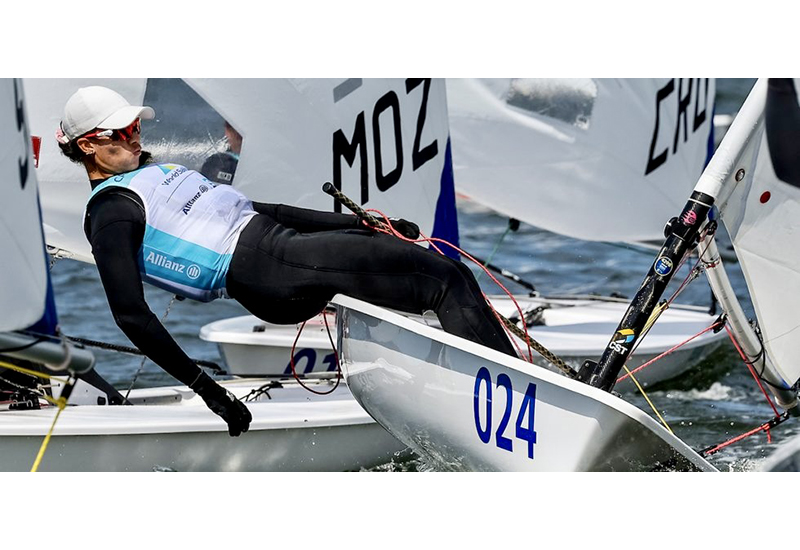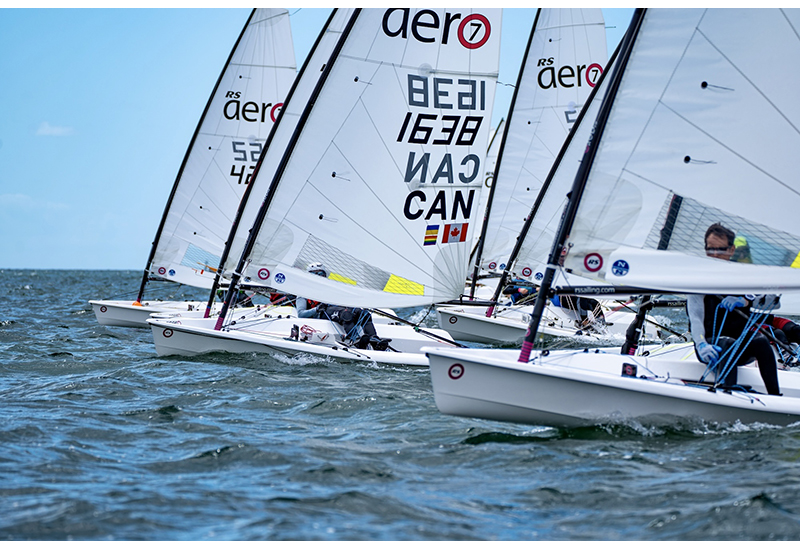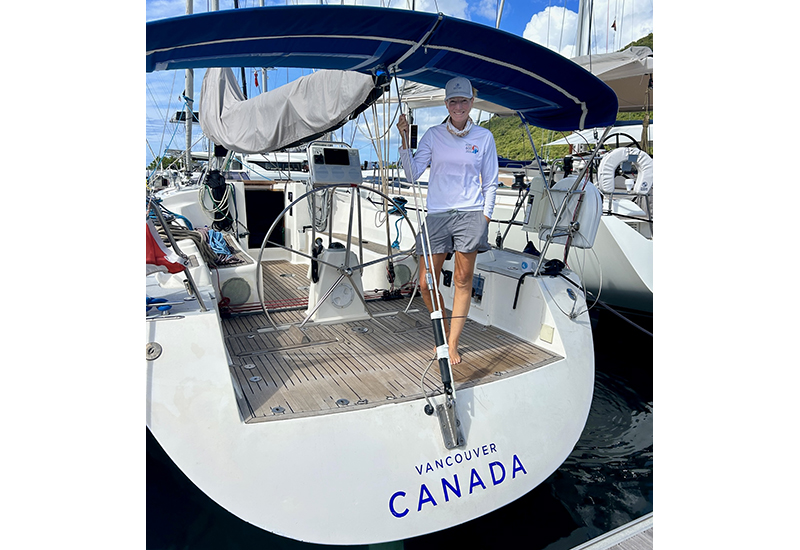The Rules Guy: Penalties – When and How to Take Them
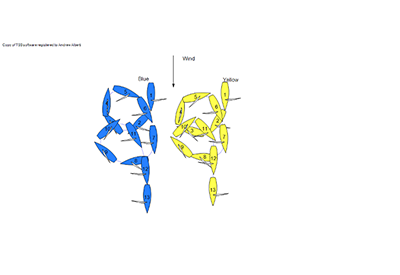
Feb 16, 2022
This discussion is based on a situation that took place at the Tokyo 2020 Olympics (held in the summer of 2021) and some local youth regattas.
When I first started to race, if you broke a rule, your only option was to drop out (or be protested out) of the race. This was a severe penalty for a simple incident. Racing evolved and some alternative penalties were introduced. The default for most infractions is now the two-turns penalty. If you, on port tack, misjudge crossing a starboard tacker and force them to alter course to avoid you, you must do two turns or risk a protest.

We can see the description of the two-turns penalty in rule 44.2. These two turns have to be taken in the same direction and each must include a tack and a gybe. In the diagram, we see that the Blue boat started downwind on starboard tack. Between position 3 and 5, Blue tacks. Between position 7 and 8, Blue gybes. Between position 9 and 10, she tacks again. She then starts to sail downwind on port tack. As she has not completed two turns, each consisting including a tack and a gybe, she has not discharged her obligation. Yellow does complete a second gybe so she has completed her penalty.
Similar problems happen to boats sailing upwind who do two gybes, but only one tack. To ensure that you have completed a penalty, remember that when finished, you will be on the same tack or gybe when you finish the penalty as when you began the two turns. In the diagram, Yellow starts her penalty on starboard tack and finishes there as well.
Sailing instructions can change the penalty. The two most common changes are to change to a one-turn penalty or to change it to a scoring penalty. Sometimes the penalty is two turns within the zone of the mark and one turn elsewhere. You need to read the sailing instructions to be sure. Some clubs use a scoring penalty, so for instance in those races, if you come off the starting line and drive down into the boat below you, forcing them to alter course to avoid you, you should put up a yellow flag and accept a 20% scoring penalty.
There is an exception to these penalties covered in rule 44.1(b). If the incident causes injury or significant damage, then these penalties are not enough and you must retire. Also, if you gain an advantage despite taking the penalty, then the turns or the 20% are not enough and you have to retire.
It is up to each competitor to know that they have broken a rule and to take the penalty. If you knowingly break a rule and don’t take a penalty, then you have breached the principles of sportsmanship and fair play and broken rule 2. If the protest committee finds that you have broken rule 2, you are then given a Disqualification Not Excludable (a DNE) that you cannot drop or exclude from your score.
So far, we have talked about situations where you have decided that you have broken a rule. There are also situations where a judge on the water may tell you that you have broken a rule. The most common form of this is when the regatta, commonly a larger dinghy regatta, is using Appendix P to enforce rule 42, the propulsion rule. At these regattas, judges in small power boats are on the racecourse looking for violations of rule 42, such as sculling at the starting line or rocking the boat downwind. If a judge finds that a boat has broken rule 42, they wave a yellow flag and call out the sail number of that boat. If this is the first time during the regatta that this boat has been caught, they must do a two-turns penalty. If they don’t do the two-turns penalty, they are disqualified.
At the Sail Canada Youth Championships this summer, two local sailors were flagged, and they did part of their turns. Since they (like the Blue boat above) did not complete their penalty, they were disqualified from the race. One of the youth sailors ended up finishing as the top female sailor in that Youth Championships despite her disqualification, so it didn’t hurt too much, but it was unfortunate, unnecessary and potentially disastrous.
These problems don’t just happen to local youth sailors. If you get a second rule 42 penalty in a regatta, you must drop out of the race. If you don’t drop out, you end up with a DNE (which as I said earlier, is a blot on your score that cannot be excluded). At the Tokyo Olympics in the last race before the medal race, the Danish single-handed female sailor, Anne-Marie Rindom (racing against our own Sarah Douglas) was flagged on the starting line. This was her second rule 42 violation, so she had to drop out of the race. There was then a General Recall. This meant that the race was restarted. According to rule 36, when the race was restarted she was now allowed to sail. She didn’t realize this and didn’t race. She had previously had a substantial lead in the regatta, but it was significantly reduced when she didn’t race, meaning that she had to have a good finish in the final medal race. She did have a good enough finish and ended up winning the Olympic Gold Medal. If she hadn’t, she might have lost the Gold by not knowing her rules.
| 2 FAIR SAILING
A boat and her owner shall compete in compliance with recognized principles of sportsmanship and fair play. A boat may be penalized under this rule only if it is clearly established that these principles have been violated. The penalty shall be a disqualification that is not excludable. 36 RACES RESTARTED OR RESAILED If a race is restarted or resailed, a breach of a rule in the original race, or in any previous restart or resail of that race, shall not (a) prohibit a boat from competing unless she has broken rule 30.4; or (b) cause a boat to be penalized except under rule 2, 30.2, 30.4 or 69 or under rule 14 when she has caused injury or serious damage. 44 PENALTIES AT THE TIME OF AN INCIDENT 44.1 Taking a Penalty A boat may take a Two-Turns Penalty when she may have broken one or more rules of Part 2 in an incident while racing. She may take a One-Turn Penalty when she may have broken rule 31. Alternatively, the notice of race or sailing instructions may specify the use of the Scoring Penalty or some other penalty, in which case the specified penalty shall replace the One-Turn and the Two-Turns Penalty. However, (a) when a boat may have broken a rule of Part 2 and rule 31 in the same incident she need not take the penalty for breaking rule 31; (b) if the boat caused injury or serious damage or, despite taking a penalty, gained a significant advantage in the race or series by her breach her penalty shall be to retire. 44.2 One-Turn and Two-Turns Penalties After getting well clear of other boats as soon after the incident as possible, a boat takes a One-Turn or Two-Turns Penalty by promptly making the required number of turns in the same direction, each turn including one tack and one gybe. When a boat takes the penalty at or near the finishing line, her hull shall be completely on the course side of the line before she finishes. 44.3 Scoring Penalty (a) A boat takes a Scoring Penalty by displaying a yellow flag at the first reasonable opportunity after the incident. (b) When a boat has taken a Scoring Penalty, she shall keep the yellow flag displayed until finishing and call the race committee’s attention to it at the finishing line. At that time she shall also inform the race committee of the identity of the other boat involved in the incident. If this is impracticable, she shall do so at the first reasonable opportunity and within the protest time limit. (c) The race score for a boat that takes a Scoring Penalty shall be the score she would have received without that penalty, made worse by the number of places stated in the notice of race or sailing instructions. When the number of places is not stated, the penalty shall be 20% of the score for Did Not Finish. P2 PENALTIES P2.1 First Penalty When a boat is first penalized under rule P1.2 her penalty shall be a Two-Turns Penalty under rule 44.2. If she fails to take it she shall be disqualified without a hearing. P2.2 Second Penalty When a boat is penalized a second time during the event, she shall promptly retire. If she fails to do so she shall be disqualified without a hearing and her score shall not be excluded. P2.3 Third and Subsequent Penalties When a boat is penalized a third or subsequent time during the event, she shall promptly retire. If she does so her penalty shall be disqualification without a hearing and her score shall not be excluded. If she fails to do so her penalty shall be disqualification without a hearing from all races in the event, with no score excluded, and the protest committee shall consider calling a hearing under rule 69.2. |
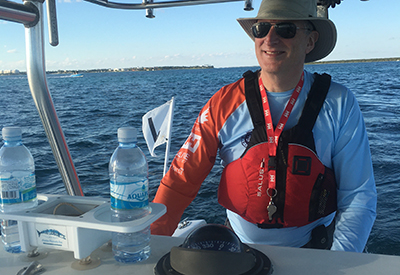 Andrew Alberti is an International Judge and National Umpire. He is a member of the Sail Canada Rules and Appeals Committees. Send your questions to Andrew at kyrules@alberti.ca
Andrew Alberti is an International Judge and National Umpire. He is a member of the Sail Canada Rules and Appeals Committees. Send your questions to Andrew at kyrules@alberti.ca

